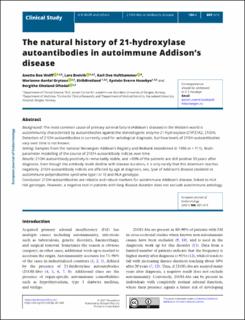| dc.contributor.author | Wolff, Anette Susanne Bøe | |
| dc.contributor.author | Breivik, Lars Ertesvåg | |
| dc.contributor.author | Hufthammer, Karl Ove | |
| dc.contributor.author | Grytaas, Marianne | |
| dc.contributor.author | Bratland, Eirik | |
| dc.contributor.author | Husebye, Eystein Sverre | |
| dc.contributor.author | Oftedal, Bergithe Eikeland | |
| dc.date.accessioned | 2021-11-29T10:39:28Z | |
| dc.date.available | 2021-11-29T10:39:28Z | |
| dc.date.created | 2021-11-23T10:03:41Z | |
| dc.date.issued | 2021 | |
| dc.identifier.issn | 0804-4643 | |
| dc.identifier.uri | https://hdl.handle.net/11250/2831865 | |
| dc.description.abstract | Background: The most common cause of primary adrenal failure (Addison’s disease) in the Western world is autoimmunity characterized by autoantibodies against the steroidogenic enzyme 21-hydroxylase (CYP21A2, 21OH). Detection of 21OH-autoantibodies is currently used for aetiological diagnosis, but how levels of 21OH-autoantibodies vary over time is not known.
Setting: Samples from the national Norwegian Addison’s Registry and Biobank established in 1996 (n = 711). Multi-parameter modelling of the course of 21OH-autoantibody indices over time.
Results: 21OH-autoantibody positivity is remarkably stable, and >90% of the patients are still positive 30 years after diagnosis. Even though the antibody levels decline with disease duration, it is only rarely that this downturn reaches negativity. 21OH-autoantibody indices are affected by age at diagnosis, sex, type of Addison’s disease (isolated vs autoimmune polyendocrine syndrome type I or II) and HLA genotype.
Conclusion: 21OH-autoantibodies are reliable and robust markers for autoimmune Addison’s disease, linked to HLA risk genotype. However, a negative test in patients with long disease duration does not exclude autoimmune aetiology. | en_US |
| dc.language.iso | eng | en_US |
| dc.publisher | Bioscientifica | en_US |
| dc.rights | Navngivelse 4.0 Internasjonal | * |
| dc.rights.uri | http://creativecommons.org/licenses/by/4.0/deed.no | * |
| dc.title | The natural history of 21-hydroxylase autoantibodies in autoimmune Addison’s disease | en_US |
| dc.type | Journal article | en_US |
| dc.type | Peer reviewed | en_US |
| dc.description.version | publishedVersion | en_US |
| dc.rights.holder | Copyright 2021 the authors | en_US |
| cristin.ispublished | true | |
| cristin.fulltext | original | |
| cristin.qualitycode | 2 | |
| dc.identifier.doi | 10.1530/EJE-20-1268 | |
| dc.identifier.cristin | 1957619 | |
| dc.source.journal | European Journal of Endocrinology (EJE) | en_US |
| dc.source.pagenumber | 607-615 | en_US |
| dc.identifier.citation | European Journal of Endocrinology (EJE). 2021, 184 (4), 607-615. | en_US |
| dc.source.volume | 184 | en_US |
| dc.source.issue | 4 | en_US |

